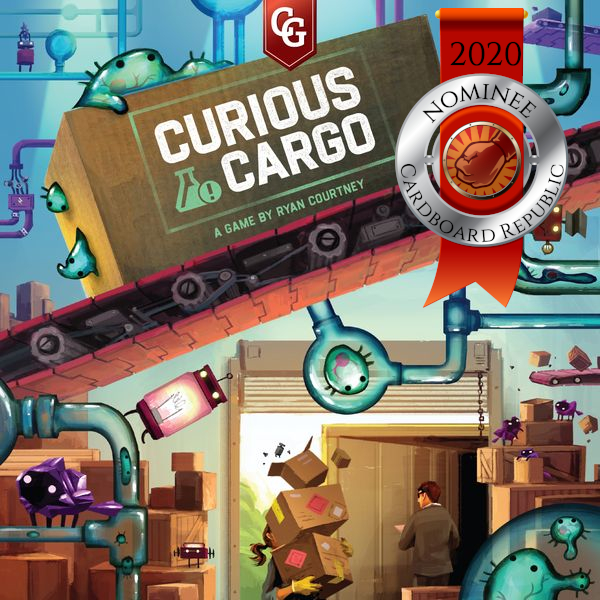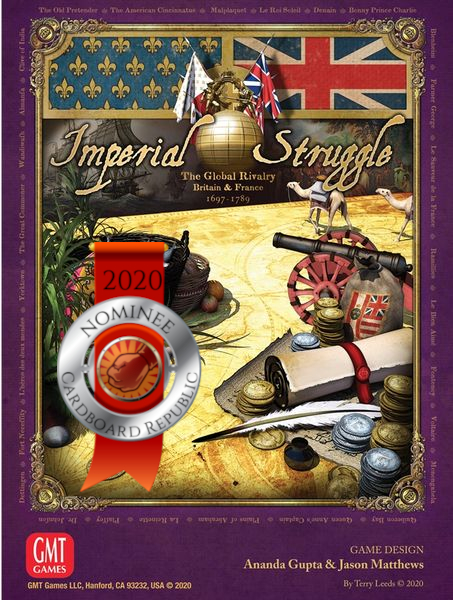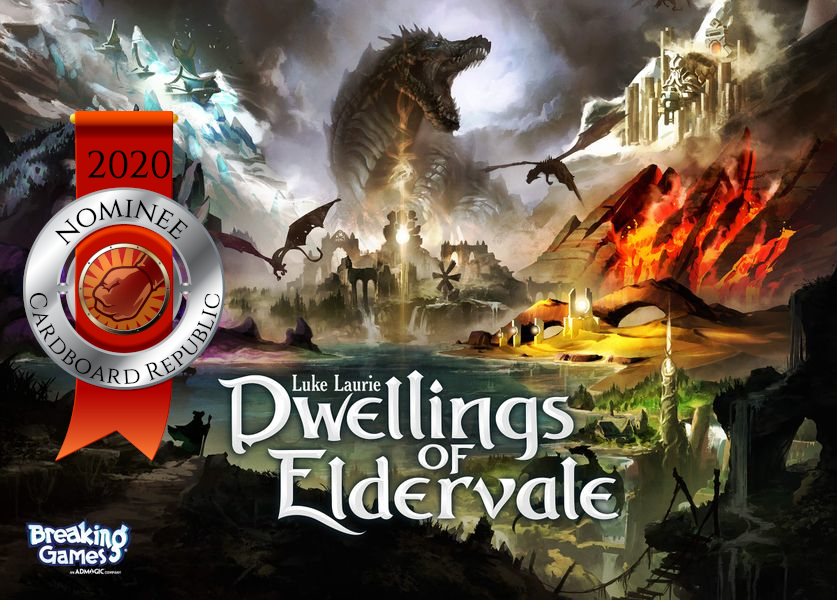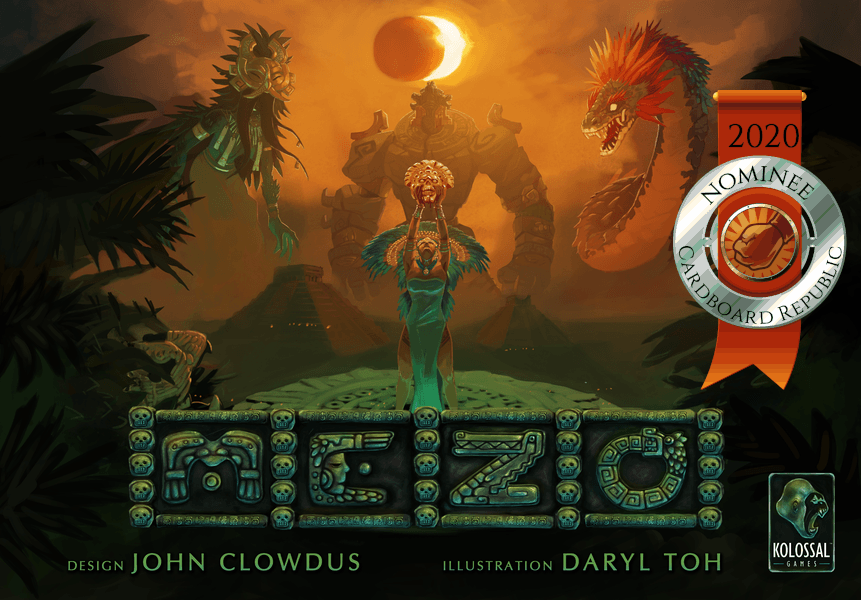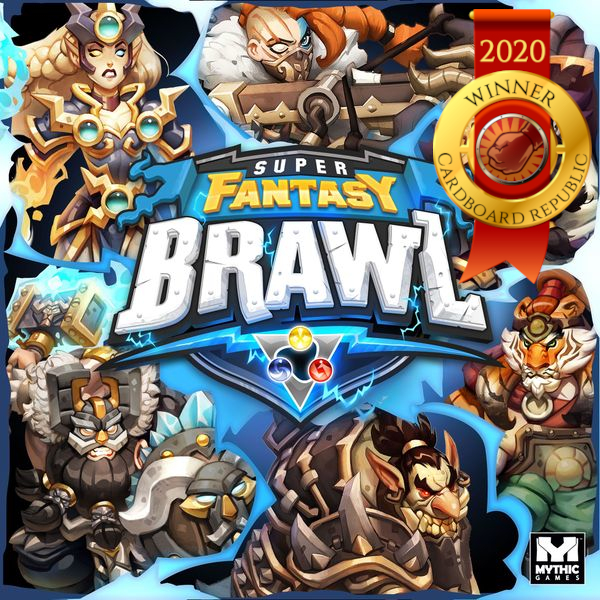The Cardboard Republic has rolled out the annual Laurels of the Republic awards, celebrating the best new games released in 2020 for each of the gamer archetypes. What follows are the finalists for one of those groups.
 Always looking for the next conflict, Strikers are those who prefer to make bold, declarative statements in their games. Their ambitions are simple: win by any means necessary, and do it quickly if possible. Strikers thrive in games where there are clear goals and the player’s chances of a particular strategy isn’t going to completely fall apart due to high degrees of luck or overly-lengthy affairs where their opponents will have ample opportunities to stop them. In short, the best Striker games are those where they are given a pointy stick and told in which direction to swing it.
Always looking for the next conflict, Strikers are those who prefer to make bold, declarative statements in their games. Their ambitions are simple: win by any means necessary, and do it quickly if possible. Strikers thrive in games where there are clear goals and the player’s chances of a particular strategy isn’t going to completely fall apart due to high degrees of luck or overly-lengthy affairs where their opponents will have ample opportunities to stop them. In short, the best Striker games are those where they are given a pointy stick and told in which direction to swing it.
And with that, here are The 2020 Laurel Finalists for Strikers:
Honorable Mention: 1565, St. Elmo’s Pay: The Great Siege of Malta
Publisher: Hall or Nothing Productions | Players: 1-2 | Play Time: 30-45 Minutes
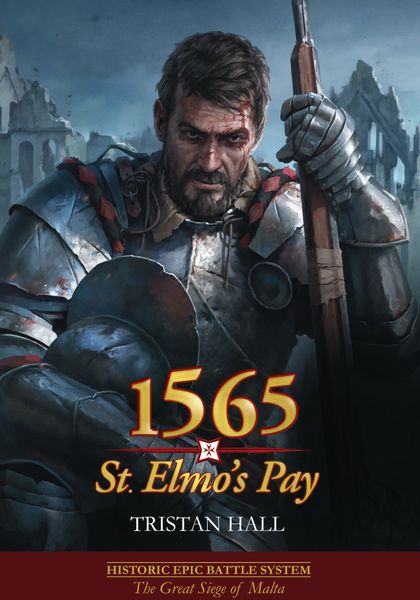
We’ll fully admit that this one comes close to a make-up pick. Technically St. Elmo’s Pay isn’t an expansion or reboot but a complete standalone follow-up to the highly regarded 2018 title, 1066: Tears to Many Mothers – a historically-themed asymmetric tactical card game about the famous Battle of Hastings. 1066 met with high praise from the outset, and it actually just missed being part of the 2018 Striker nominees by the absolute slimmest of margins. St. Elmo’s utilizes the vast majority of the same game system as 1066, so much so that the factions are technically cross-compatible, though St. Elmo’s does add some slight variations. This circumstances in 2020 afforded this clever and tense battlefield foray a better chance, and so here we are.
In this two-player clash of rival forces, you are recreating the 1565 siege of Malta. One player takes up the mantle of the fierce and relentless armies of the Ottoman Turks, while the other becomes the vastly overwhelmed and outnumbered Knights of St. John seeking to defend the tiny island of Malta from their modest fortress.
This was the ‘300’ of its day.
Yet unlike typical tactical battlefield games, victory in 1565 isn’t solely based on opposing forces lining up on a field of battle. Yes, marshalling cards onto the board at one of the game’s three contested locations is important as units each provide some amount of Might or Zeal, the game’s two resources. Those resources can be used to pay for card effects or move the game along. But like its predecessor, before you can actually face your opponent in 1565 you must first race through a fixed deck of objective cards requiring those same resources. This deck, much like every name and setting in the game, is steeped in actual history. Only when you reach the final objective can you actually claim locations or attack the enemy leader. And it is that frantic balance between creating board advantage while trying to get to the finish line before your opponent where the game truly comes alive.
St. Elmo’s Pay is one part race, one part combat, one part tactical planning, and one part resource optimization. With concrete goals, player-driven outcomes, and a straightforward ruleset, 1565 is a game that puts your side’s fate squarely in your hands. For this group, that’s a setting hard to say no to – no matter the odds.
The Nominees
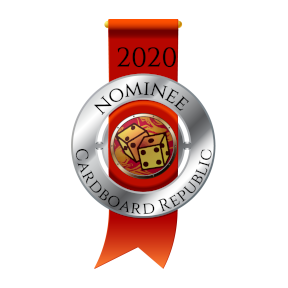
Number Five: Curious Cargo
Publisher: Capstone Games | Players: 2 | Play Time: 30-60 Minutes
Prepare to sit yourselves down and strap in for the high octane, electrifying world of…warehouse logistics!
Admittedly, despite a theme that could’ve easily found itself the punchline of a joke from The IT Crowd, Curious Cargo is a concise, lightweight exercise more nuanced than initially appears.
The game takes place at an undisclosed warehouse probably operating just this side of legal. But your fascination isn’t with the materials themselves, their purpose, or the destinations thereof. Instead, it’s all about their manufacturing and distribution.
Over the course of the game, both players operate their own gridded warehouse, complete with a handful of production machines and 10 loading & receiving bays on each side of the board. Your primary goal, essentially, is to be the most productive at shipping out your goods while trying to receive goods from your opponent.
Unlike actual shipping logistics, the rules to Curious Cargo are remarkably concise. Accomplishing your goal, on the other hand, is a bit trickier.
Operating in dual phase rounds, the first part consists of drawing and / or playing pipeline tiles to your warehouse. Pipelines are either red or blue, denoting the two types of goods you’re working with, and while you have ample freedom to place, rotate, and overlap these tiles – lending to a fair amount of spatial processing – your goal is pretty basic: complete pipelines of the same color from your machines your loading bays. Then, players have the chance to summon trucks of varying sizes to the shipping side of either board; should that push an existing truck off your board, it drives on over to the other player. If one of your pipelines connects to an empty truck space on your shipping side, you get to ship out a good of that color. Connecting a pipeline to a matching good on the receiving side lets you collect that good instead. Both are beneficial and can provide VP. Such is the way of commerce.
Although there’s some randomness to the tile and card draws, Curious Cargo appeals to Strikers so because beneath its dry veneer is a quick but rich game with an interconnected and even symbiotic relationship between achieving your own goals and disrupting the other player. In this game, they are often two sides of the same coin. In Curious Cargo timed interference with your competition isn’t personal, just business. And they’re perfectly fine with that.
Number Four: Imperial Struggle
Publisher: GMT Games | Players: 2 | Play Time: 120-240 Minutes
One of the few overarching characteristics to Strikers as a group is that they generally eschew lengthy and complex games because it often allows for opponents to catch up or have their efforts undermined by the culmination of some long simmering master counterstroke. Simply put, they prefer the battle over the war.
So if there were any puzzlement over how one of their top games of the year is a 3 hour wargame of imperial conquest, it would be justified.
Though it bears the looks and trappings of one, the truth is at its heart Imperial Struggle is not actually a wargame, nor is it focused on military domination.
It is, largely, just an expansive area majority game.
Designed by the same duo as 2005’s Twilight Struggle (judged among many in board gaming to be among the best games ever made) and billed as a slightly more complex successor, Imperial Struggle is set over the span of nearly 100 years, from the start of the 18th century to the start of the French Revolution. It pits two players, as France and Britain, against one another across decades of conflict and upheaval. Through the use action tokens and TS-style event cards, players spend six rounds, briefly interspersed with four major war resolutions, focusing on extending influence into territories across three continents.
As the game makes resoundingly clear, however, you cannot do it all – which is both the beauty and the challenge. Imperial Struggle isn’t one long military campaign but instead rounds of 8 continually-shifting VP opportunities to work towards, be they economic, political, or, yes, military in nature – all backstopped against impending wars on the horizon. It also serves as a subtle but inherent backdoor indictment about the both the hubris of the entire imperial ethos – as a bunch of unelected rulers 4Xed their way across the globe for centuries – as well as how inherently tenuous such imposing exploits are.
Thanks to its dynamic gameplay, low-luck environment, ever-changing goals, and unencumbered ability to pivot from one fight to the next, Imperial Struggle reveals itself to be less a game of one main objective than it is 50 minor ones. And long though it may be, all that fits right into this group’s bailiwick.
Number Three: Dwellings of Eldervale
Publisher: Breaking Games | Players: 1-5 | Play Time: 60-150 Minutes
Although every nominee on this list offers a palpable table presence due to stellar production quality, imposing miniatures, or a captivating mosaic of tokens, none can compete with the vast sprawling array of colorful tiles, dice, cards, and meeples that Dwellings of Eldervale proudly brings to bear. With hundreds of components and 16 playable factions, there’s an impressive and even slightly intimidating array of stuff to process in this game that mixes worker placement, area control and tableau building.
Welcome to Eldervale, the most aggressive game about the right to build houses in territories that make Mordor look cheery by comparison and takes the lack of affordable housing to some unintentionally laughable conclusions.
In this game, each player leads a unique faction to explore and control territories, establish dwellings, grow in power, and battle anyone – or anything – that stands in your way. Factions are tied to one of the game’s 8 element types, which determine not only the board makeup and available tableau cards but also stipulate which schools of magic players can advance in that game through purchasing cards and building houses. It is through these building and advancement processes where most VP is gained.
By contrast, while combat is commonplace and jockeying for control of specific tiles is an essential element in Eldervale, it’s generally a means to an end.
Despite all this, turns in Eldervale are remarkably binary: until the map is fully explored or someone builds their 6th ramshackle hut you either place a worker or recall them all home. Placing workers allows for a host of possible effects, from gaining resources to tableau upgrades to combat. Recalling workers simply pulls your units back. Living units can be used to activate tableau abilities such as building a house. Meanwhile since Hades is apparently on vacation, dead units simply wander back from the underworld.
Though Eldervale throws a lot at you and some moments can pivot on luck-based outcomes, the bulk of the game operates in an alluringly straightforward way that Strikers adore: build houses, gain power, and try to hamstring others from accomplishing the same. With an almost dizzying amount of gameplay variability, clear-cut workable goals, and the ability to be assertive without tipping into punishing, Dwellings of Eldervale is a laudable middleweight conflict-driven realm that this group has no trouble residing in.
Number Two: Mezo
Publisher: Kolossal Games | Players: 2-4 | Play Time: 90-120 Minutes
There was no shortage of area control games to choose from in 2020, be they those with tiny footprints to expansive panoplies brimming with plastic and resin and more cardboard than an Amazon warehouse. Smack in the middle of that was Mezo, a typical-seeming “dudes on a map’ affair with a handful of towering Mayan god miniatures serving as avatars for its refreshingly well-researched Maya-based theme.
And while may be tempting to declare it Blood Rage in the Yucatan, it’d bely the fact that Mezo may just be the most adept combat-centric title yet at conveying what it would be like if power-hungry gods directly stepped into the conflicts of mortals.
Designer John Clowdus has been a designer of small, concise, compact games for many years, with a particular penchant for a ‘less is more’ approach to rules and where seemingly limited options lead to interesting emergent gameplay. That pedigree is on full display in Mezo, all blown up and prettified. And it works.
Over three rounds as Mayan gods, players command their followers to compete over who can give them the most devotion, with the victor inevitably going to the deity most successful. Yet these gods don’t just loom large over the proceedings as players take turns deploying warriors and shamans to various regions – they have an active hand in them.
Much of the ingenuity in Mezo emanates from the asymmetric antics of the gods themselves: each possessing their own mythologically-fitting powers and play styles to leverage as you position units, plan for upcoming fights, and promulgate your will around the board. At each region every round players take actions to manipulate the circumstances before scoring based on who has the strongest remaining unit strength. One specially designed region per round is resolved separately – not by demonstrating physical strength but in celebration of their respective gods by sacrificing followers to the underworld.
It was a different time.
Through its novel and interconnected use of player powers, Mezo is a violence-infused clash of gods and mortals where life and death are inextricably intertwined. It boasts copious player-driven agency dictating its outcomes and a heavy, straightforward emphasis on winning as many skirmishes as possible as the primary path to immortal glory. For Strikers, this straightforward, engaging, and thematic test of their battlefield mettle is nothing short of an answered prayer.
And it came pretty close to this year’s Laurel, if not for a late year arrival of another title commanding a very similar energy…
The Winner
2020 Striker Laurel – Super Fantasy Brawl
Publisher: Mythic Games | Players: 2-4 | Play Time: 30-45 Minutes
In recent years Mythic Games has quickly established itself as a successful purveyor of visually appealing games packed to the gills with flavorful miniatures. But none of their titles embody that mix of trademark aesthetic with widescale accessibility than the fantasy-laden arena style tussle that is Super Fantasy Brawl.
In this magic-laden realm, arcane forces have made massive armed conflict a thing of the past. To sate their appetite for conflict, its people created the gladiatorial sport which the game is based around.
Think if Rome were set in Azeroth.
In the fast-paced and energy-inducing Super Fantasy Brawl, each player assembles a squad of three distinct characters from among the game’s lineup, each specializing in offensive, defensive, or manipulation abilities. Their associated cards are mixed together to form your deck for the game, leading to an admirable degree of strategic variation from one session to the next. Depending on the makeup of your heroic triad, play styles in SFB vary wildly from guarded posturing and deceptive feints to channeling your inner Leeroy Jenkins as you charge across the grounds with wild abandon. All of which are fully capable of delivering you unto victory.
In expected fashion, players take turns playing cards, one from each of the game’s three color-coded spheres of magic to move, defend, manipulate the board, and initiate a variety of attacks upon the opposition. What sets Brawl apart from becoming a generic knock-down, drag-out fighting game overladen with minis, however, is that while you do benefit from pummeling an opponent’s hero into the sand, such confrontation is not the sole vehicle to winning. Instead, the driving mission is to achieve a randomized set of objectives, which range as much from briefly holding specific spaces or performing specific maneuvers as is it scoring a temporary TKO.
Brawl may outwardly feel like a deathmatch, but it’s both more robust and elegant than that. Here, whichever player reaches 5 points wins, leading to an electric mix of alternating between claiming goals for yourself while negating your opponent from doing the same.
With brisk and energetic gameplay, extensive replayabilty, and success propelled by skillful deployment of your characters as well as balancing its innate push-and-pull elements, Super Fantasy Brawl is a game where triumphing is almost entirely within your own blood-stained hands. And it is precisely that approach why it’s worthy of this group’s top trophy of 2020.
![]()
Super Fantasy Brawl Contest!
When it came to figuring out how we wanted to show off this year’s Striker Laurel we initially thought it would be rather fitting to determine the winner of the prize as part of a grand melee, with the last person standing declared the victor. We went so far as to look into pricing out some nearby paddocks in which players could run about with foam weaponry, makeshift armor, and a bevy of objects hidden about to help ensure you were the last person standing. Unfortunately, that whole thing fell apart for a few reasons. For one, you know, the whole pandemic thing would have wrecked attendance numbers. For another, after a few days in it was pretty evident that we had accidentally designed a LARP instead in the process. Mostly though, we were told that no matter how safe we could make it, liability insurance would cost us an arm and a leg. (Which honestly we thought was fitting but probably also proved their point.) We simply couldn’t handle another temporary dismemberment lawsuit. So in the end we scaled our ambitions back and instead opted for the most direct approach: providing one lucky winner with the opportunity to enjoy the award-winning game first hand. That is what we’re going to to do right…now.
That’s right! Enter below for your chance at your very own copy of Super Fantasy Brawl!
One Copy of Super Fantasy Brawl
Note: In honor of their award recognition, Mythic Games has kindly provided a copy of this game for giveaway purposes.
![]()
Be sure to check out the 2020 Laurel Award pages for the other archetypes once they go live!

